Business Law Report: Lily Communication and Legal Requirements
VerifiedAdded on 2023/01/13
|16
|6438
|21
Report
AI Summary
This business law report analyzes various aspects of the UK legal framework relevant to businesses, using Lily Communication as a case study. It begins by examining statutory interpretation rules, the differences between civil and criminal law, EU law creation and its impact, and features of the English legal system. The report then delves into contract law, identifying key requirements, misrepresentation types and remedies, illegal contract types, and contract creation/discharge. Further, it explores the Sales of Goods Act, covering ownership transfer, buyer/seller duties, and remedies for breaches. Finally, the report investigates the legal characteristics of companies, director appointments/removals, company control/management, creditor responsibilities under the Consumer Credit Act, and intellectual property rights like copyright, patents, and trademarks. The report provides a comprehensive overview of legal considerations for businesses operating in the UK.
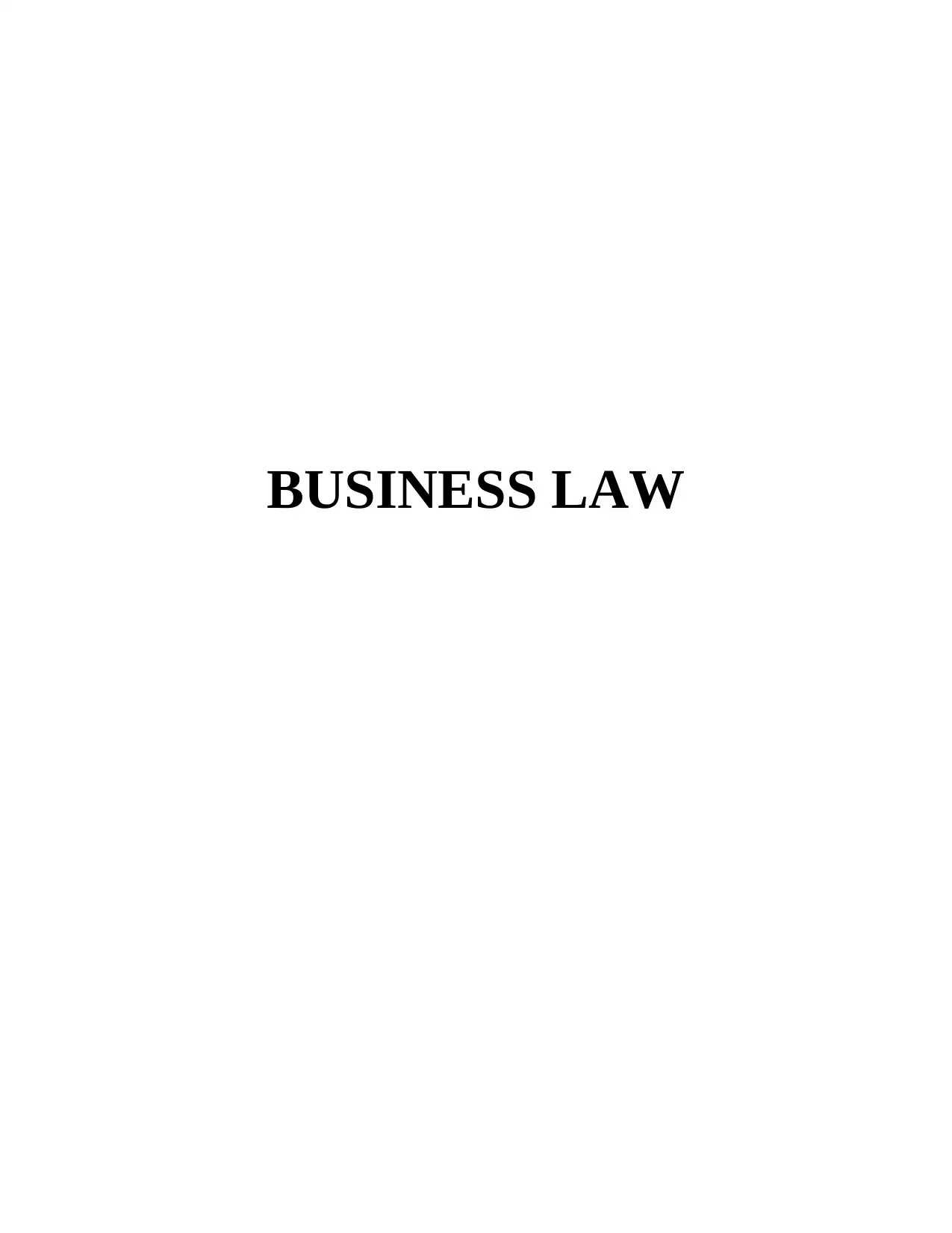
BUSINESS LAW
Paraphrase This Document
Need a fresh take? Get an instant paraphrase of this document with our AI Paraphraser
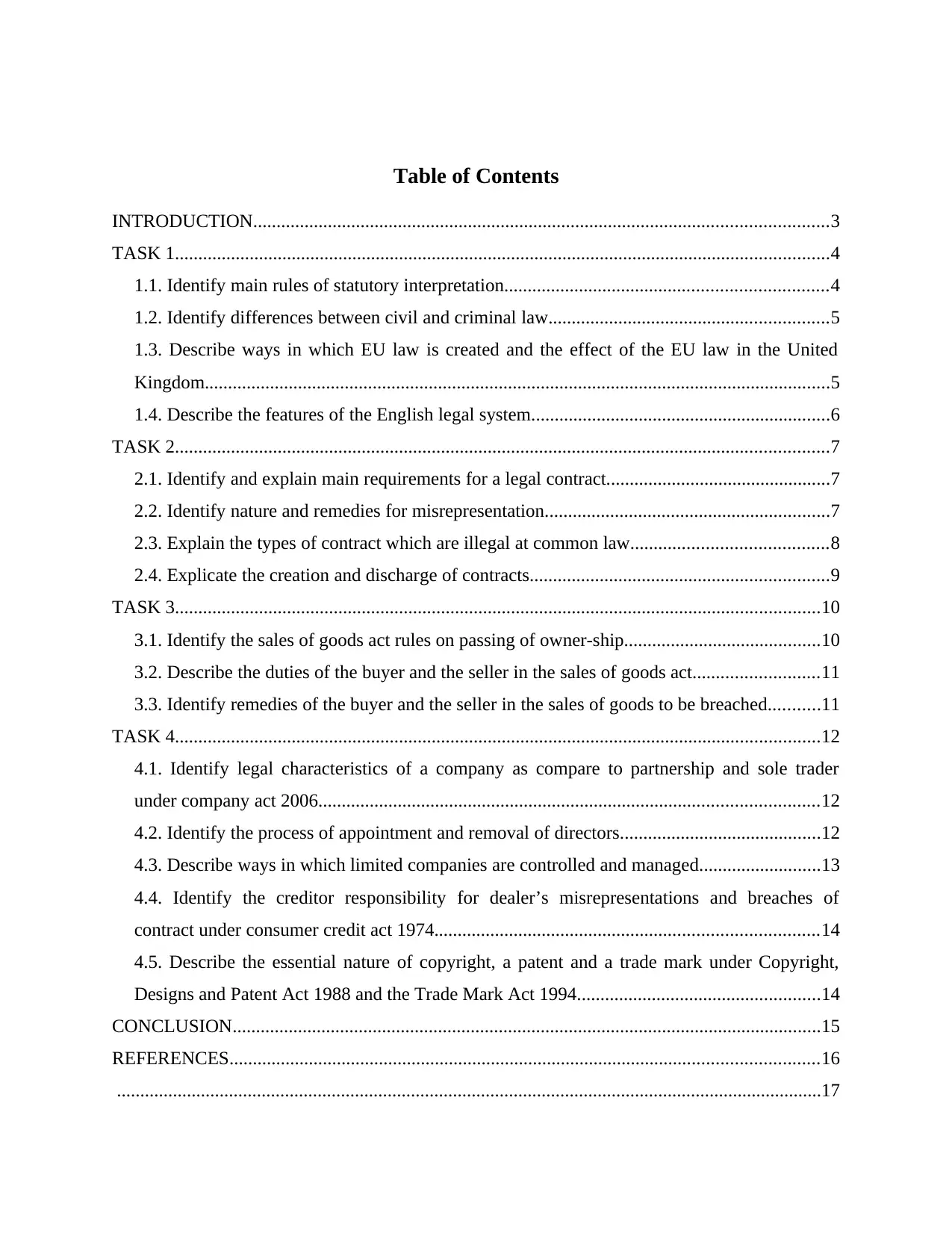
Table of Contents
INTRODUCTION...........................................................................................................................3
TASK 1............................................................................................................................................4
1.1. Identify main rules of statutory interpretation.....................................................................4
1.2. Identify differences between civil and criminal law............................................................5
1.3. Describe ways in which EU law is created and the effect of the EU law in the United
Kingdom......................................................................................................................................5
1.4. Describe the features of the English legal system................................................................6
TASK 2............................................................................................................................................7
2.1. Identify and explain main requirements for a legal contract................................................7
2.2. Identify nature and remedies for misrepresentation.............................................................7
2.3. Explain the types of contract which are illegal at common law..........................................8
2.4. Explicate the creation and discharge of contracts................................................................9
TASK 3..........................................................................................................................................10
3.1. Identify the sales of goods act rules on passing of owner-ship..........................................10
3.2. Describe the duties of the buyer and the seller in the sales of goods act...........................11
3.3. Identify remedies of the buyer and the seller in the sales of goods to be breached...........11
TASK 4..........................................................................................................................................12
4.1. Identify legal characteristics of a company as compare to partnership and sole trader
under company act 2006...........................................................................................................12
4.2. Identify the process of appointment and removal of directors...........................................12
4.3. Describe ways in which limited companies are controlled and managed..........................13
4.4. Identify the creditor responsibility for dealer’s misrepresentations and breaches of
contract under consumer credit act 1974..................................................................................14
4.5. Describe the essential nature of copyright, a patent and a trade mark under Copyright,
Designs and Patent Act 1988 and the Trade Mark Act 1994....................................................14
CONCLUSION..............................................................................................................................15
REFERENCES..............................................................................................................................16
.......................................................................................................................................................17
INTRODUCTION...........................................................................................................................3
TASK 1............................................................................................................................................4
1.1. Identify main rules of statutory interpretation.....................................................................4
1.2. Identify differences between civil and criminal law............................................................5
1.3. Describe ways in which EU law is created and the effect of the EU law in the United
Kingdom......................................................................................................................................5
1.4. Describe the features of the English legal system................................................................6
TASK 2............................................................................................................................................7
2.1. Identify and explain main requirements for a legal contract................................................7
2.2. Identify nature and remedies for misrepresentation.............................................................7
2.3. Explain the types of contract which are illegal at common law..........................................8
2.4. Explicate the creation and discharge of contracts................................................................9
TASK 3..........................................................................................................................................10
3.1. Identify the sales of goods act rules on passing of owner-ship..........................................10
3.2. Describe the duties of the buyer and the seller in the sales of goods act...........................11
3.3. Identify remedies of the buyer and the seller in the sales of goods to be breached...........11
TASK 4..........................................................................................................................................12
4.1. Identify legal characteristics of a company as compare to partnership and sole trader
under company act 2006...........................................................................................................12
4.2. Identify the process of appointment and removal of directors...........................................12
4.3. Describe ways in which limited companies are controlled and managed..........................13
4.4. Identify the creditor responsibility for dealer’s misrepresentations and breaches of
contract under consumer credit act 1974..................................................................................14
4.5. Describe the essential nature of copyright, a patent and a trade mark under Copyright,
Designs and Patent Act 1988 and the Trade Mark Act 1994....................................................14
CONCLUSION..............................................................................................................................15
REFERENCES..............................................................................................................................16
.......................................................................................................................................................17
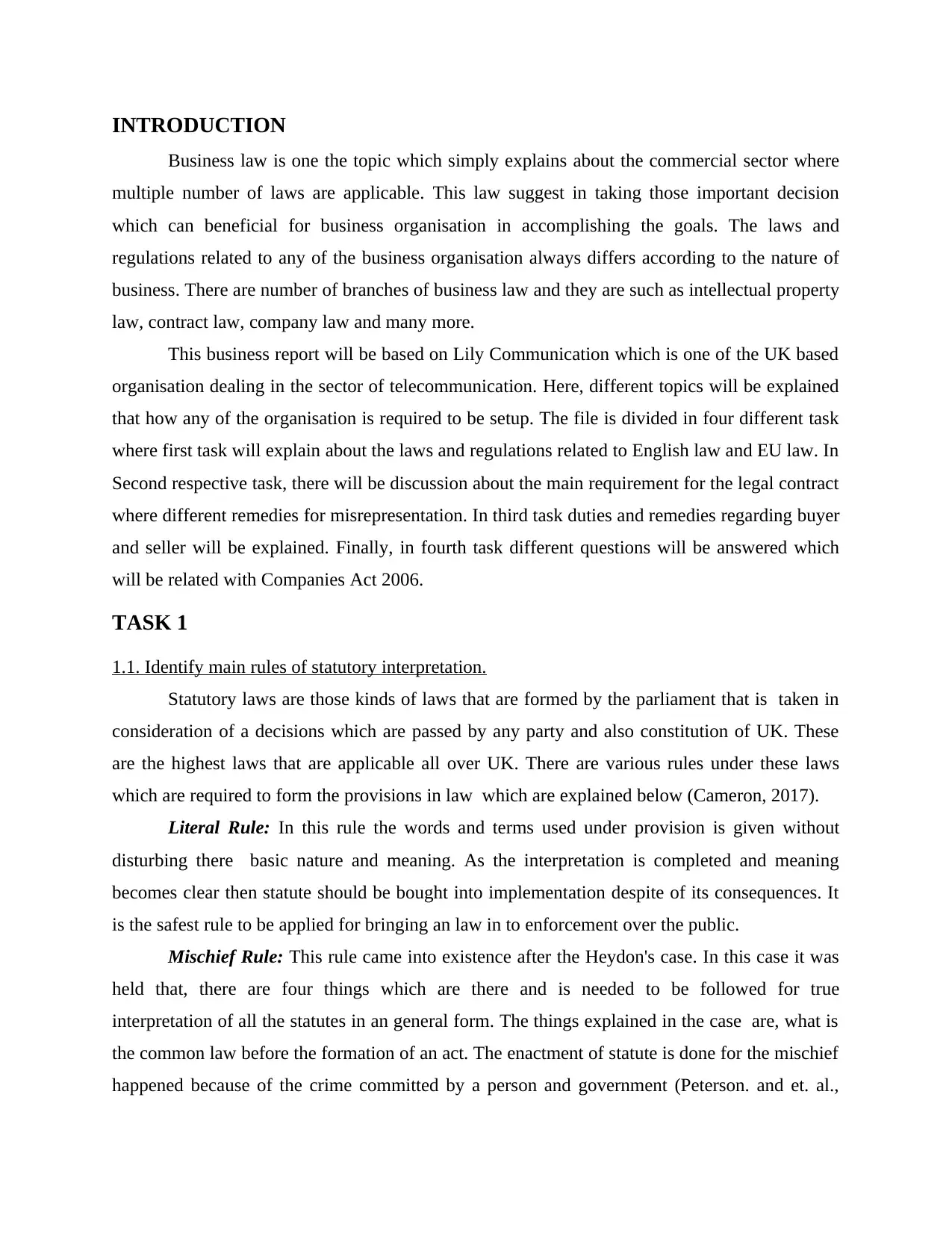
INTRODUCTION
Business law is one the topic which simply explains about the commercial sector where
multiple number of laws are applicable. This law suggest in taking those important decision
which can beneficial for business organisation in accomplishing the goals. The laws and
regulations related to any of the business organisation always differs according to the nature of
business. There are number of branches of business law and they are such as intellectual property
law, contract law, company law and many more.
This business report will be based on Lily Communication which is one of the UK based
organisation dealing in the sector of telecommunication. Here, different topics will be explained
that how any of the organisation is required to be setup. The file is divided in four different task
where first task will explain about the laws and regulations related to English law and EU law. In
Second respective task, there will be discussion about the main requirement for the legal contract
where different remedies for misrepresentation. In third task duties and remedies regarding buyer
and seller will be explained. Finally, in fourth task different questions will be answered which
will be related with Companies Act 2006.
TASK 1
1.1. Identify main rules of statutory interpretation.
Statutory laws are those kinds of laws that are formed by the parliament that is taken in
consideration of a decisions which are passed by any party and also constitution of UK. These
are the highest laws that are applicable all over UK. There are various rules under these laws
which are required to form the provisions in law which are explained below (Cameron, 2017).
Literal Rule: In this rule the words and terms used under provision is given without
disturbing there basic nature and meaning. As the interpretation is completed and meaning
becomes clear then statute should be bought into implementation despite of its consequences. It
is the safest rule to be applied for bringing an law in to enforcement over the public.
Mischief Rule: This rule came into existence after the Heydon's case. In this case it was
held that, there are four things which are there and is needed to be followed for true
interpretation of all the statutes in an general form. The things explained in the case are, what is
the common law before the formation of an act. The enactment of statute is done for the mischief
happened because of the crime committed by a person and government (Peterson. and et. al.,
Business law is one the topic which simply explains about the commercial sector where
multiple number of laws are applicable. This law suggest in taking those important decision
which can beneficial for business organisation in accomplishing the goals. The laws and
regulations related to any of the business organisation always differs according to the nature of
business. There are number of branches of business law and they are such as intellectual property
law, contract law, company law and many more.
This business report will be based on Lily Communication which is one of the UK based
organisation dealing in the sector of telecommunication. Here, different topics will be explained
that how any of the organisation is required to be setup. The file is divided in four different task
where first task will explain about the laws and regulations related to English law and EU law. In
Second respective task, there will be discussion about the main requirement for the legal contract
where different remedies for misrepresentation. In third task duties and remedies regarding buyer
and seller will be explained. Finally, in fourth task different questions will be answered which
will be related with Companies Act 2006.
TASK 1
1.1. Identify main rules of statutory interpretation.
Statutory laws are those kinds of laws that are formed by the parliament that is taken in
consideration of a decisions which are passed by any party and also constitution of UK. These
are the highest laws that are applicable all over UK. There are various rules under these laws
which are required to form the provisions in law which are explained below (Cameron, 2017).
Literal Rule: In this rule the words and terms used under provision is given without
disturbing there basic nature and meaning. As the interpretation is completed and meaning
becomes clear then statute should be bought into implementation despite of its consequences. It
is the safest rule to be applied for bringing an law in to enforcement over the public.
Mischief Rule: This rule came into existence after the Heydon's case. In this case it was
held that, there are four things which are there and is needed to be followed for true
interpretation of all the statutes in an general form. The things explained in the case are, what is
the common law before the formation of an act. The enactment of statute is done for the mischief
happened because of the crime committed by a person and government (Peterson. and et. al.,
⊘ This is a preview!⊘
Do you want full access?
Subscribe today to unlock all pages.

Trusted by 1+ million students worldwide
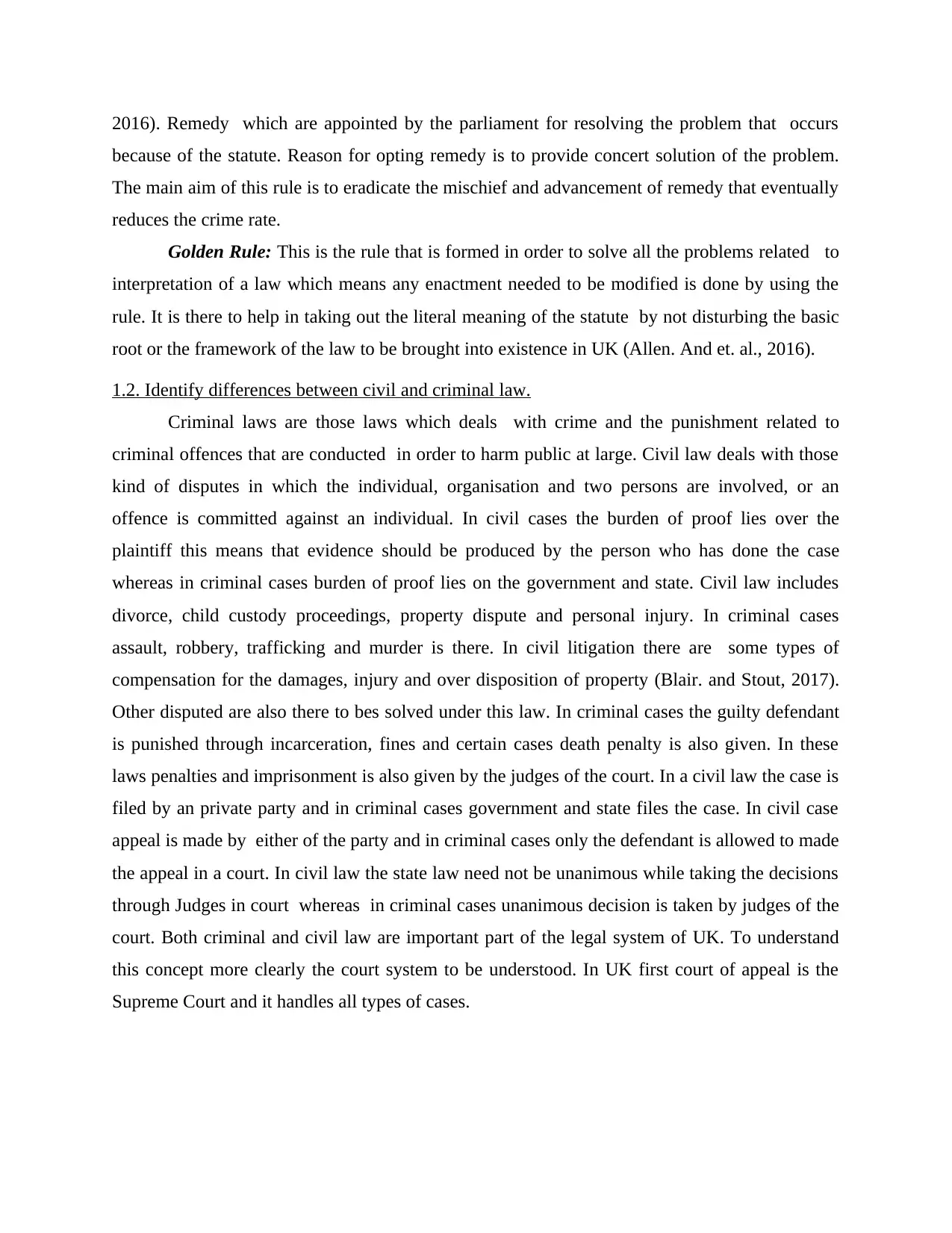
2016). Remedy which are appointed by the parliament for resolving the problem that occurs
because of the statute. Reason for opting remedy is to provide concert solution of the problem.
The main aim of this rule is to eradicate the mischief and advancement of remedy that eventually
reduces the crime rate.
Golden Rule: This is the rule that is formed in order to solve all the problems related to
interpretation of a law which means any enactment needed to be modified is done by using the
rule. It is there to help in taking out the literal meaning of the statute by not disturbing the basic
root or the framework of the law to be brought into existence in UK (Allen. And et. al., 2016).
1.2. Identify differences between civil and criminal law.
Criminal laws are those laws which deals with crime and the punishment related to
criminal offences that are conducted in order to harm public at large. Civil law deals with those
kind of disputes in which the individual, organisation and two persons are involved, or an
offence is committed against an individual. In civil cases the burden of proof lies over the
plaintiff this means that evidence should be produced by the person who has done the case
whereas in criminal cases burden of proof lies on the government and state. Civil law includes
divorce, child custody proceedings, property dispute and personal injury. In criminal cases
assault, robbery, trafficking and murder is there. In civil litigation there are some types of
compensation for the damages, injury and over disposition of property (Blair. and Stout, 2017).
Other disputed are also there to bes solved under this law. In criminal cases the guilty defendant
is punished through incarceration, fines and certain cases death penalty is also given. In these
laws penalties and imprisonment is also given by the judges of the court. In a civil law the case is
filed by an private party and in criminal cases government and state files the case. In civil case
appeal is made by either of the party and in criminal cases only the defendant is allowed to made
the appeal in a court. In civil law the state law need not be unanimous while taking the decisions
through Judges in court whereas in criminal cases unanimous decision is taken by judges of the
court. Both criminal and civil law are important part of the legal system of UK. To understand
this concept more clearly the court system to be understood. In UK first court of appeal is the
Supreme Court and it handles all types of cases.
because of the statute. Reason for opting remedy is to provide concert solution of the problem.
The main aim of this rule is to eradicate the mischief and advancement of remedy that eventually
reduces the crime rate.
Golden Rule: This is the rule that is formed in order to solve all the problems related to
interpretation of a law which means any enactment needed to be modified is done by using the
rule. It is there to help in taking out the literal meaning of the statute by not disturbing the basic
root or the framework of the law to be brought into existence in UK (Allen. And et. al., 2016).
1.2. Identify differences between civil and criminal law.
Criminal laws are those laws which deals with crime and the punishment related to
criminal offences that are conducted in order to harm public at large. Civil law deals with those
kind of disputes in which the individual, organisation and two persons are involved, or an
offence is committed against an individual. In civil cases the burden of proof lies over the
plaintiff this means that evidence should be produced by the person who has done the case
whereas in criminal cases burden of proof lies on the government and state. Civil law includes
divorce, child custody proceedings, property dispute and personal injury. In criminal cases
assault, robbery, trafficking and murder is there. In civil litigation there are some types of
compensation for the damages, injury and over disposition of property (Blair. and Stout, 2017).
Other disputed are also there to bes solved under this law. In criminal cases the guilty defendant
is punished through incarceration, fines and certain cases death penalty is also given. In these
laws penalties and imprisonment is also given by the judges of the court. In a civil law the case is
filed by an private party and in criminal cases government and state files the case. In civil case
appeal is made by either of the party and in criminal cases only the defendant is allowed to made
the appeal in a court. In civil law the state law need not be unanimous while taking the decisions
through Judges in court whereas in criminal cases unanimous decision is taken by judges of the
court. Both criminal and civil law are important part of the legal system of UK. To understand
this concept more clearly the court system to be understood. In UK first court of appeal is the
Supreme Court and it handles all types of cases.
Paraphrase This Document
Need a fresh take? Get an instant paraphrase of this document with our AI Paraphraser
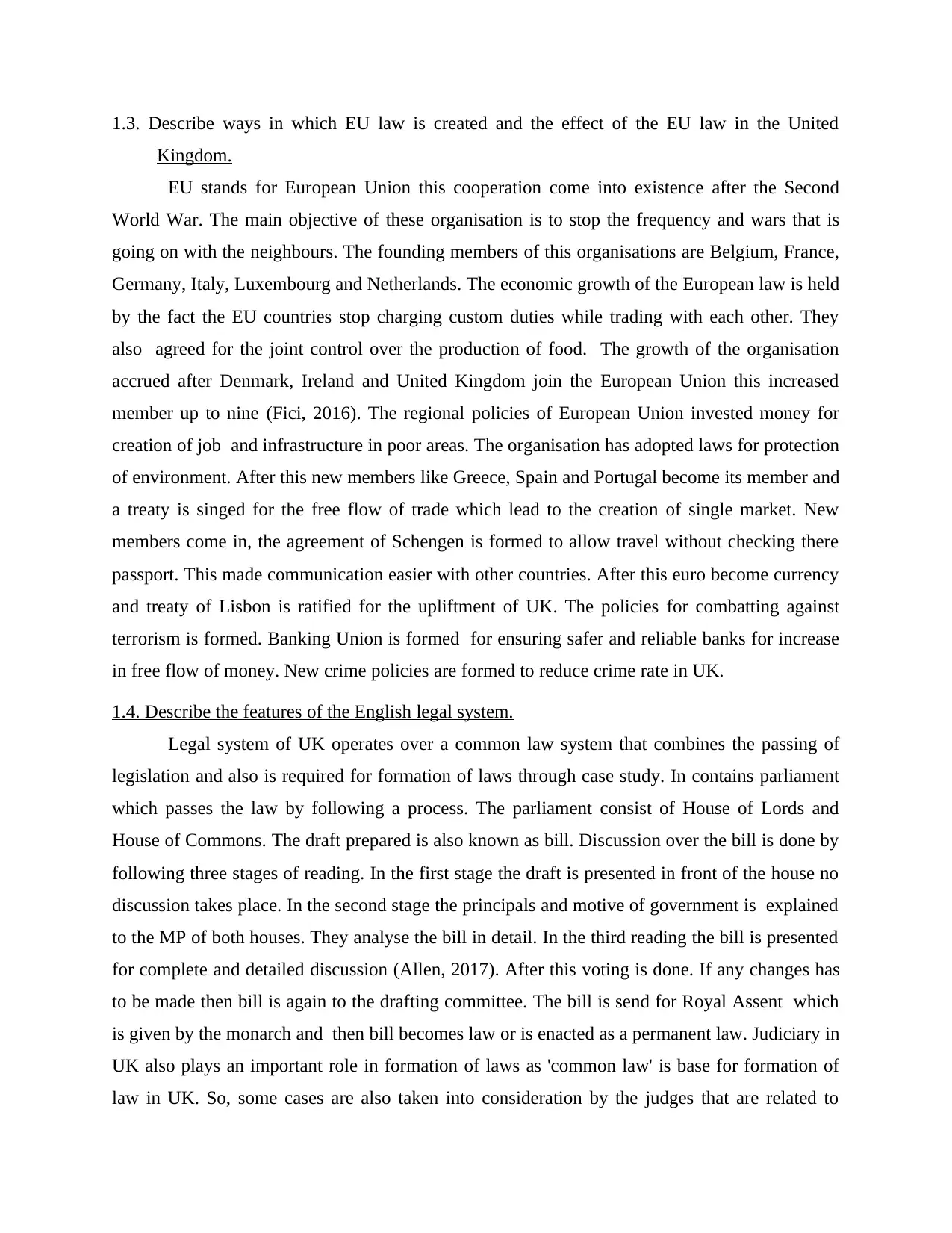
1.3. Describe ways in which EU law is created and the effect of the EU law in the United
Kingdom.
EU stands for European Union this cooperation come into existence after the Second
World War. The main objective of these organisation is to stop the frequency and wars that is
going on with the neighbours. The founding members of this organisations are Belgium, France,
Germany, Italy, Luxembourg and Netherlands. The economic growth of the European law is held
by the fact the EU countries stop charging custom duties while trading with each other. They
also agreed for the joint control over the production of food. The growth of the organisation
accrued after Denmark, Ireland and United Kingdom join the European Union this increased
member up to nine (Fici, 2016). The regional policies of European Union invested money for
creation of job and infrastructure in poor areas. The organisation has adopted laws for protection
of environment. After this new members like Greece, Spain and Portugal become its member and
a treaty is singed for the free flow of trade which lead to the creation of single market. New
members come in, the agreement of Schengen is formed to allow travel without checking there
passport. This made communication easier with other countries. After this euro become currency
and treaty of Lisbon is ratified for the upliftment of UK. The policies for combatting against
terrorism is formed. Banking Union is formed for ensuring safer and reliable banks for increase
in free flow of money. New crime policies are formed to reduce crime rate in UK.
1.4. Describe the features of the English legal system.
Legal system of UK operates over a common law system that combines the passing of
legislation and also is required for formation of laws through case study. In contains parliament
which passes the law by following a process. The parliament consist of House of Lords and
House of Commons. The draft prepared is also known as bill. Discussion over the bill is done by
following three stages of reading. In the first stage the draft is presented in front of the house no
discussion takes place. In the second stage the principals and motive of government is explained
to the MP of both houses. They analyse the bill in detail. In the third reading the bill is presented
for complete and detailed discussion (Allen, 2017). After this voting is done. If any changes has
to be made then bill is again to the drafting committee. The bill is send for Royal Assent which
is given by the monarch and then bill becomes law or is enacted as a permanent law. Judiciary in
UK also plays an important role in formation of laws as 'common law' is base for formation of
law in UK. So, some cases are also taken into consideration by the judges that are related to
Kingdom.
EU stands for European Union this cooperation come into existence after the Second
World War. The main objective of these organisation is to stop the frequency and wars that is
going on with the neighbours. The founding members of this organisations are Belgium, France,
Germany, Italy, Luxembourg and Netherlands. The economic growth of the European law is held
by the fact the EU countries stop charging custom duties while trading with each other. They
also agreed for the joint control over the production of food. The growth of the organisation
accrued after Denmark, Ireland and United Kingdom join the European Union this increased
member up to nine (Fici, 2016). The regional policies of European Union invested money for
creation of job and infrastructure in poor areas. The organisation has adopted laws for protection
of environment. After this new members like Greece, Spain and Portugal become its member and
a treaty is singed for the free flow of trade which lead to the creation of single market. New
members come in, the agreement of Schengen is formed to allow travel without checking there
passport. This made communication easier with other countries. After this euro become currency
and treaty of Lisbon is ratified for the upliftment of UK. The policies for combatting against
terrorism is formed. Banking Union is formed for ensuring safer and reliable banks for increase
in free flow of money. New crime policies are formed to reduce crime rate in UK.
1.4. Describe the features of the English legal system.
Legal system of UK operates over a common law system that combines the passing of
legislation and also is required for formation of laws through case study. In contains parliament
which passes the law by following a process. The parliament consist of House of Lords and
House of Commons. The draft prepared is also known as bill. Discussion over the bill is done by
following three stages of reading. In the first stage the draft is presented in front of the house no
discussion takes place. In the second stage the principals and motive of government is explained
to the MP of both houses. They analyse the bill in detail. In the third reading the bill is presented
for complete and detailed discussion (Allen, 2017). After this voting is done. If any changes has
to be made then bill is again to the drafting committee. The bill is send for Royal Assent which
is given by the monarch and then bill becomes law or is enacted as a permanent law. Judiciary in
UK also plays an important role in formation of laws as 'common law' is base for formation of
law in UK. So, some cases are also taken into consideration by the judges that are related to
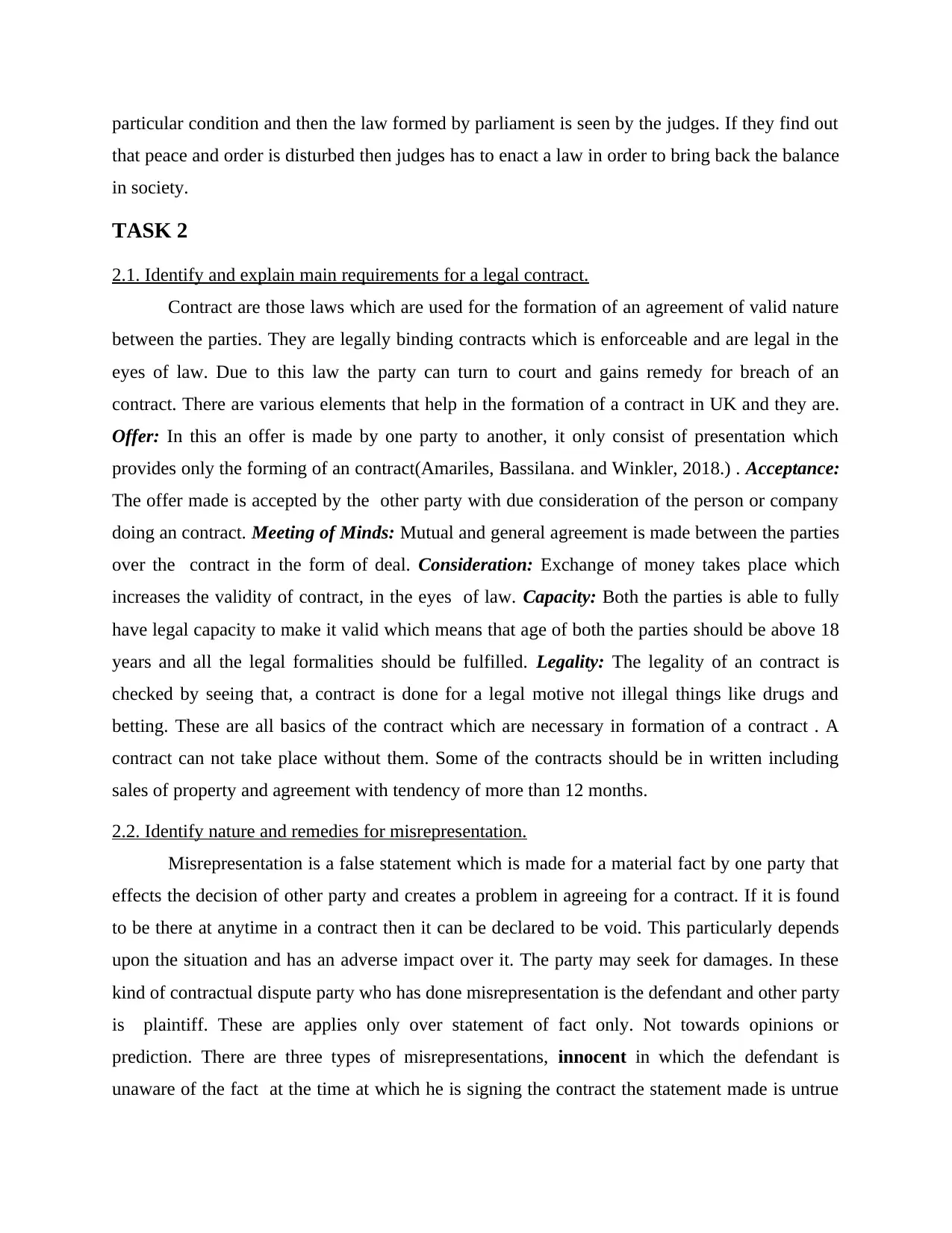
particular condition and then the law formed by parliament is seen by the judges. If they find out
that peace and order is disturbed then judges has to enact a law in order to bring back the balance
in society.
TASK 2
2.1. Identify and explain main requirements for a legal contract.
Contract are those laws which are used for the formation of an agreement of valid nature
between the parties. They are legally binding contracts which is enforceable and are legal in the
eyes of law. Due to this law the party can turn to court and gains remedy for breach of an
contract. There are various elements that help in the formation of a contract in UK and they are.
Offer: In this an offer is made by one party to another, it only consist of presentation which
provides only the forming of an contract(Amariles, Bassilana. and Winkler, 2018.) . Acceptance:
The offer made is accepted by the other party with due consideration of the person or company
doing an contract. Meeting of Minds: Mutual and general agreement is made between the parties
over the contract in the form of deal. Consideration: Exchange of money takes place which
increases the validity of contract, in the eyes of law. Capacity: Both the parties is able to fully
have legal capacity to make it valid which means that age of both the parties should be above 18
years and all the legal formalities should be fulfilled. Legality: The legality of an contract is
checked by seeing that, a contract is done for a legal motive not illegal things like drugs and
betting. These are all basics of the contract which are necessary in formation of a contract . A
contract can not take place without them. Some of the contracts should be in written including
sales of property and agreement with tendency of more than 12 months.
2.2. Identify nature and remedies for misrepresentation.
Misrepresentation is a false statement which is made for a material fact by one party that
effects the decision of other party and creates a problem in agreeing for a contract. If it is found
to be there at anytime in a contract then it can be declared to be void. This particularly depends
upon the situation and has an adverse impact over it. The party may seek for damages. In these
kind of contractual dispute party who has done misrepresentation is the defendant and other party
is plaintiff. These are applies only over statement of fact only. Not towards opinions or
prediction. There are three types of misrepresentations, innocent in which the defendant is
unaware of the fact at the time at which he is signing the contract the statement made is untrue
that peace and order is disturbed then judges has to enact a law in order to bring back the balance
in society.
TASK 2
2.1. Identify and explain main requirements for a legal contract.
Contract are those laws which are used for the formation of an agreement of valid nature
between the parties. They are legally binding contracts which is enforceable and are legal in the
eyes of law. Due to this law the party can turn to court and gains remedy for breach of an
contract. There are various elements that help in the formation of a contract in UK and they are.
Offer: In this an offer is made by one party to another, it only consist of presentation which
provides only the forming of an contract(Amariles, Bassilana. and Winkler, 2018.) . Acceptance:
The offer made is accepted by the other party with due consideration of the person or company
doing an contract. Meeting of Minds: Mutual and general agreement is made between the parties
over the contract in the form of deal. Consideration: Exchange of money takes place which
increases the validity of contract, in the eyes of law. Capacity: Both the parties is able to fully
have legal capacity to make it valid which means that age of both the parties should be above 18
years and all the legal formalities should be fulfilled. Legality: The legality of an contract is
checked by seeing that, a contract is done for a legal motive not illegal things like drugs and
betting. These are all basics of the contract which are necessary in formation of a contract . A
contract can not take place without them. Some of the contracts should be in written including
sales of property and agreement with tendency of more than 12 months.
2.2. Identify nature and remedies for misrepresentation.
Misrepresentation is a false statement which is made for a material fact by one party that
effects the decision of other party and creates a problem in agreeing for a contract. If it is found
to be there at anytime in a contract then it can be declared to be void. This particularly depends
upon the situation and has an adverse impact over it. The party may seek for damages. In these
kind of contractual dispute party who has done misrepresentation is the defendant and other party
is plaintiff. These are applies only over statement of fact only. Not towards opinions or
prediction. There are three types of misrepresentations, innocent in which the defendant is
unaware of the fact at the time at which he is signing the contract the statement made is untrue
⊘ This is a preview!⊘
Do you want full access?
Subscribe today to unlock all pages.

Trusted by 1+ million students worldwide
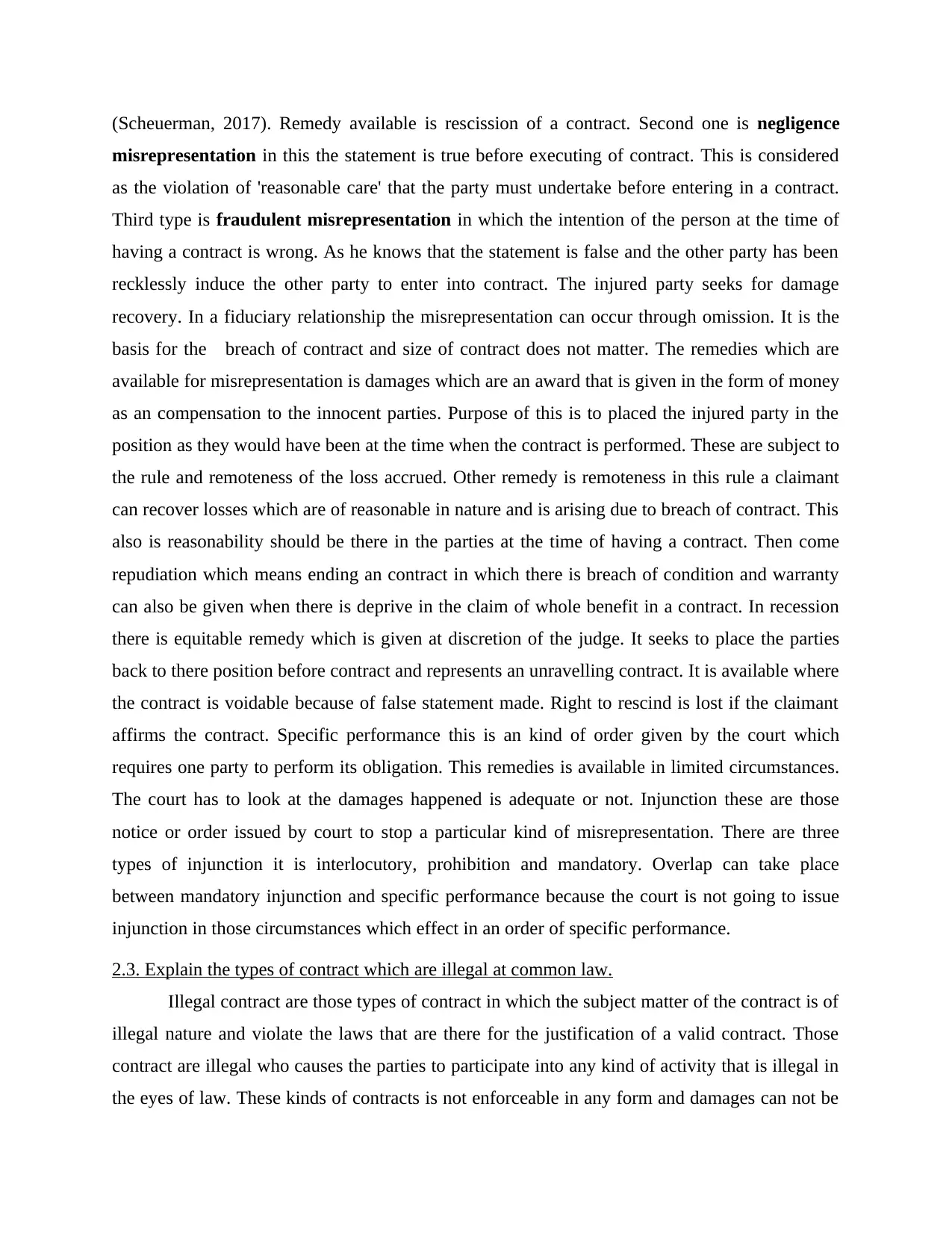
(Scheuerman, 2017). Remedy available is rescission of a contract. Second one is negligence
misrepresentation in this the statement is true before executing of contract. This is considered
as the violation of 'reasonable care' that the party must undertake before entering in a contract.
Third type is fraudulent misrepresentation in which the intention of the person at the time of
having a contract is wrong. As he knows that the statement is false and the other party has been
recklessly induce the other party to enter into contract. The injured party seeks for damage
recovery. In a fiduciary relationship the misrepresentation can occur through omission. It is the
basis for the breach of contract and size of contract does not matter. The remedies which are
available for misrepresentation is damages which are an award that is given in the form of money
as an compensation to the innocent parties. Purpose of this is to placed the injured party in the
position as they would have been at the time when the contract is performed. These are subject to
the rule and remoteness of the loss accrued. Other remedy is remoteness in this rule a claimant
can recover losses which are of reasonable in nature and is arising due to breach of contract. This
also is reasonability should be there in the parties at the time of having a contract. Then come
repudiation which means ending an contract in which there is breach of condition and warranty
can also be given when there is deprive in the claim of whole benefit in a contract. In recession
there is equitable remedy which is given at discretion of the judge. It seeks to place the parties
back to there position before contract and represents an unravelling contract. It is available where
the contract is voidable because of false statement made. Right to rescind is lost if the claimant
affirms the contract. Specific performance this is an kind of order given by the court which
requires one party to perform its obligation. This remedies is available in limited circumstances.
The court has to look at the damages happened is adequate or not. Injunction these are those
notice or order issued by court to stop a particular kind of misrepresentation. There are three
types of injunction it is interlocutory, prohibition and mandatory. Overlap can take place
between mandatory injunction and specific performance because the court is not going to issue
injunction in those circumstances which effect in an order of specific performance.
2.3. Explain the types of contract which are illegal at common law.
Illegal contract are those types of contract in which the subject matter of the contract is of
illegal nature and violate the laws that are there for the justification of a valid contract. Those
contract are illegal who causes the parties to participate into any kind of activity that is illegal in
the eyes of law. These kinds of contracts is not enforceable in any form and damages can not be
misrepresentation in this the statement is true before executing of contract. This is considered
as the violation of 'reasonable care' that the party must undertake before entering in a contract.
Third type is fraudulent misrepresentation in which the intention of the person at the time of
having a contract is wrong. As he knows that the statement is false and the other party has been
recklessly induce the other party to enter into contract. The injured party seeks for damage
recovery. In a fiduciary relationship the misrepresentation can occur through omission. It is the
basis for the breach of contract and size of contract does not matter. The remedies which are
available for misrepresentation is damages which are an award that is given in the form of money
as an compensation to the innocent parties. Purpose of this is to placed the injured party in the
position as they would have been at the time when the contract is performed. These are subject to
the rule and remoteness of the loss accrued. Other remedy is remoteness in this rule a claimant
can recover losses which are of reasonable in nature and is arising due to breach of contract. This
also is reasonability should be there in the parties at the time of having a contract. Then come
repudiation which means ending an contract in which there is breach of condition and warranty
can also be given when there is deprive in the claim of whole benefit in a contract. In recession
there is equitable remedy which is given at discretion of the judge. It seeks to place the parties
back to there position before contract and represents an unravelling contract. It is available where
the contract is voidable because of false statement made. Right to rescind is lost if the claimant
affirms the contract. Specific performance this is an kind of order given by the court which
requires one party to perform its obligation. This remedies is available in limited circumstances.
The court has to look at the damages happened is adequate or not. Injunction these are those
notice or order issued by court to stop a particular kind of misrepresentation. There are three
types of injunction it is interlocutory, prohibition and mandatory. Overlap can take place
between mandatory injunction and specific performance because the court is not going to issue
injunction in those circumstances which effect in an order of specific performance.
2.3. Explain the types of contract which are illegal at common law.
Illegal contract are those types of contract in which the subject matter of the contract is of
illegal nature and violate the laws that are there for the justification of a valid contract. Those
contract are illegal who causes the parties to participate into any kind of activity that is illegal in
the eyes of law. These kinds of contracts is not enforceable in any form and damages can not be
Paraphrase This Document
Need a fresh take? Get an instant paraphrase of this document with our AI Paraphraser
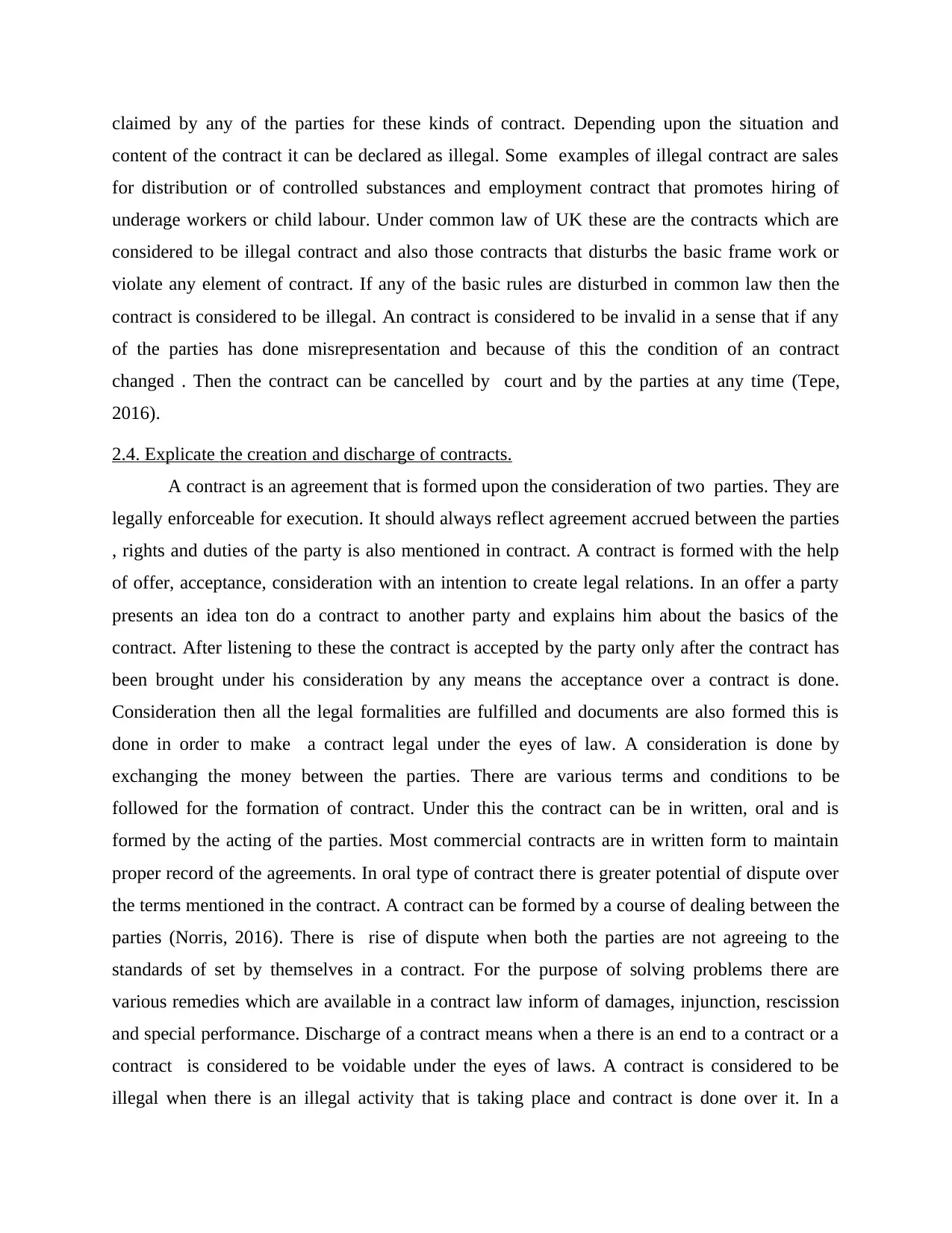
claimed by any of the parties for these kinds of contract. Depending upon the situation and
content of the contract it can be declared as illegal. Some examples of illegal contract are sales
for distribution or of controlled substances and employment contract that promotes hiring of
underage workers or child labour. Under common law of UK these are the contracts which are
considered to be illegal contract and also those contracts that disturbs the basic frame work or
violate any element of contract. If any of the basic rules are disturbed in common law then the
contract is considered to be illegal. An contract is considered to be invalid in a sense that if any
of the parties has done misrepresentation and because of this the condition of an contract
changed . Then the contract can be cancelled by court and by the parties at any time (Tepe,
2016).
2.4. Explicate the creation and discharge of contracts.
A contract is an agreement that is formed upon the consideration of two parties. They are
legally enforceable for execution. It should always reflect agreement accrued between the parties
, rights and duties of the party is also mentioned in contract. A contract is formed with the help
of offer, acceptance, consideration with an intention to create legal relations. In an offer a party
presents an idea ton do a contract to another party and explains him about the basics of the
contract. After listening to these the contract is accepted by the party only after the contract has
been brought under his consideration by any means the acceptance over a contract is done.
Consideration then all the legal formalities are fulfilled and documents are also formed this is
done in order to make a contract legal under the eyes of law. A consideration is done by
exchanging the money between the parties. There are various terms and conditions to be
followed for the formation of contract. Under this the contract can be in written, oral and is
formed by the acting of the parties. Most commercial contracts are in written form to maintain
proper record of the agreements. In oral type of contract there is greater potential of dispute over
the terms mentioned in the contract. A contract can be formed by a course of dealing between the
parties (Norris, 2016). There is rise of dispute when both the parties are not agreeing to the
standards of set by themselves in a contract. For the purpose of solving problems there are
various remedies which are available in a contract law inform of damages, injunction, rescission
and special performance. Discharge of a contract means when a there is an end to a contract or a
contract is considered to be voidable under the eyes of laws. A contract is considered to be
illegal when there is an illegal activity that is taking place and contract is done over it. In a
content of the contract it can be declared as illegal. Some examples of illegal contract are sales
for distribution or of controlled substances and employment contract that promotes hiring of
underage workers or child labour. Under common law of UK these are the contracts which are
considered to be illegal contract and also those contracts that disturbs the basic frame work or
violate any element of contract. If any of the basic rules are disturbed in common law then the
contract is considered to be illegal. An contract is considered to be invalid in a sense that if any
of the parties has done misrepresentation and because of this the condition of an contract
changed . Then the contract can be cancelled by court and by the parties at any time (Tepe,
2016).
2.4. Explicate the creation and discharge of contracts.
A contract is an agreement that is formed upon the consideration of two parties. They are
legally enforceable for execution. It should always reflect agreement accrued between the parties
, rights and duties of the party is also mentioned in contract. A contract is formed with the help
of offer, acceptance, consideration with an intention to create legal relations. In an offer a party
presents an idea ton do a contract to another party and explains him about the basics of the
contract. After listening to these the contract is accepted by the party only after the contract has
been brought under his consideration by any means the acceptance over a contract is done.
Consideration then all the legal formalities are fulfilled and documents are also formed this is
done in order to make a contract legal under the eyes of law. A consideration is done by
exchanging the money between the parties. There are various terms and conditions to be
followed for the formation of contract. Under this the contract can be in written, oral and is
formed by the acting of the parties. Most commercial contracts are in written form to maintain
proper record of the agreements. In oral type of contract there is greater potential of dispute over
the terms mentioned in the contract. A contract can be formed by a course of dealing between the
parties (Norris, 2016). There is rise of dispute when both the parties are not agreeing to the
standards of set by themselves in a contract. For the purpose of solving problems there are
various remedies which are available in a contract law inform of damages, injunction, rescission
and special performance. Discharge of a contract means when a there is an end to a contract or a
contract is considered to be voidable under the eyes of laws. A contract is considered to be
illegal when there is an illegal activity that is taking place and contract is done over it. In a
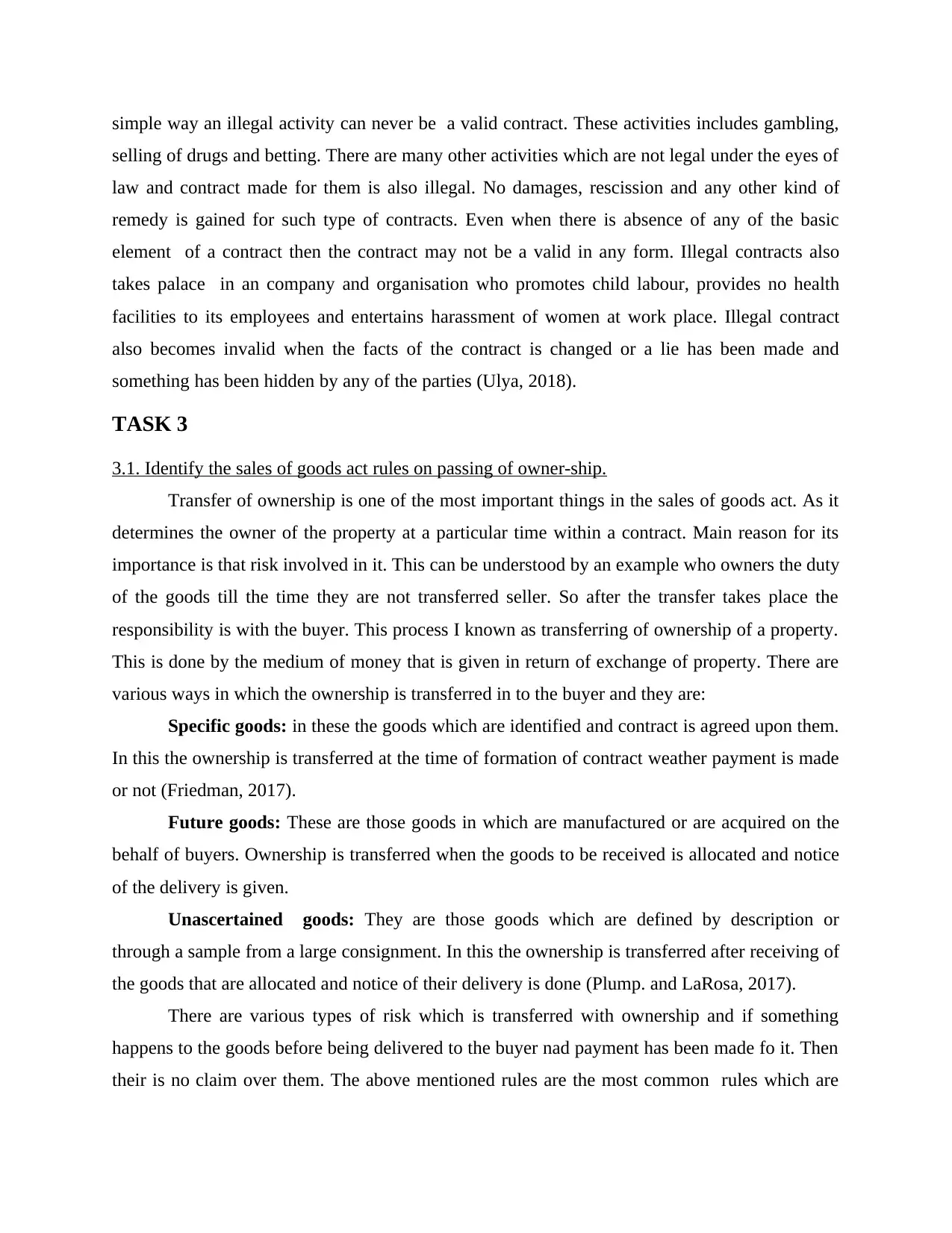
simple way an illegal activity can never be a valid contract. These activities includes gambling,
selling of drugs and betting. There are many other activities which are not legal under the eyes of
law and contract made for them is also illegal. No damages, rescission and any other kind of
remedy is gained for such type of contracts. Even when there is absence of any of the basic
element of a contract then the contract may not be a valid in any form. Illegal contracts also
takes palace in an company and organisation who promotes child labour, provides no health
facilities to its employees and entertains harassment of women at work place. Illegal contract
also becomes invalid when the facts of the contract is changed or a lie has been made and
something has been hidden by any of the parties (Ulya, 2018).
TASK 3
3.1. Identify the sales of goods act rules on passing of owner-ship.
Transfer of ownership is one of the most important things in the sales of goods act. As it
determines the owner of the property at a particular time within a contract. Main reason for its
importance is that risk involved in it. This can be understood by an example who owners the duty
of the goods till the time they are not transferred seller. So after the transfer takes place the
responsibility is with the buyer. This process I known as transferring of ownership of a property.
This is done by the medium of money that is given in return of exchange of property. There are
various ways in which the ownership is transferred in to the buyer and they are:
Specific goods: in these the goods which are identified and contract is agreed upon them.
In this the ownership is transferred at the time of formation of contract weather payment is made
or not (Friedman, 2017).
Future goods: These are those goods in which are manufactured or are acquired on the
behalf of buyers. Ownership is transferred when the goods to be received is allocated and notice
of the delivery is given.
Unascertained goods: They are those goods which are defined by description or
through a sample from a large consignment. In this the ownership is transferred after receiving of
the goods that are allocated and notice of their delivery is done (Plump. and LaRosa, 2017).
There are various types of risk which is transferred with ownership and if something
happens to the goods before being delivered to the buyer nad payment has been made fo it. Then
their is no claim over them. The above mentioned rules are the most common rules which are
selling of drugs and betting. There are many other activities which are not legal under the eyes of
law and contract made for them is also illegal. No damages, rescission and any other kind of
remedy is gained for such type of contracts. Even when there is absence of any of the basic
element of a contract then the contract may not be a valid in any form. Illegal contracts also
takes palace in an company and organisation who promotes child labour, provides no health
facilities to its employees and entertains harassment of women at work place. Illegal contract
also becomes invalid when the facts of the contract is changed or a lie has been made and
something has been hidden by any of the parties (Ulya, 2018).
TASK 3
3.1. Identify the sales of goods act rules on passing of owner-ship.
Transfer of ownership is one of the most important things in the sales of goods act. As it
determines the owner of the property at a particular time within a contract. Main reason for its
importance is that risk involved in it. This can be understood by an example who owners the duty
of the goods till the time they are not transferred seller. So after the transfer takes place the
responsibility is with the buyer. This process I known as transferring of ownership of a property.
This is done by the medium of money that is given in return of exchange of property. There are
various ways in which the ownership is transferred in to the buyer and they are:
Specific goods: in these the goods which are identified and contract is agreed upon them.
In this the ownership is transferred at the time of formation of contract weather payment is made
or not (Friedman, 2017).
Future goods: These are those goods in which are manufactured or are acquired on the
behalf of buyers. Ownership is transferred when the goods to be received is allocated and notice
of the delivery is given.
Unascertained goods: They are those goods which are defined by description or
through a sample from a large consignment. In this the ownership is transferred after receiving of
the goods that are allocated and notice of their delivery is done (Plump. and LaRosa, 2017).
There are various types of risk which is transferred with ownership and if something
happens to the goods before being delivered to the buyer nad payment has been made fo it. Then
their is no claim over them. The above mentioned rules are the most common rules which are
⊘ This is a preview!⊘
Do you want full access?
Subscribe today to unlock all pages.

Trusted by 1+ million students worldwide
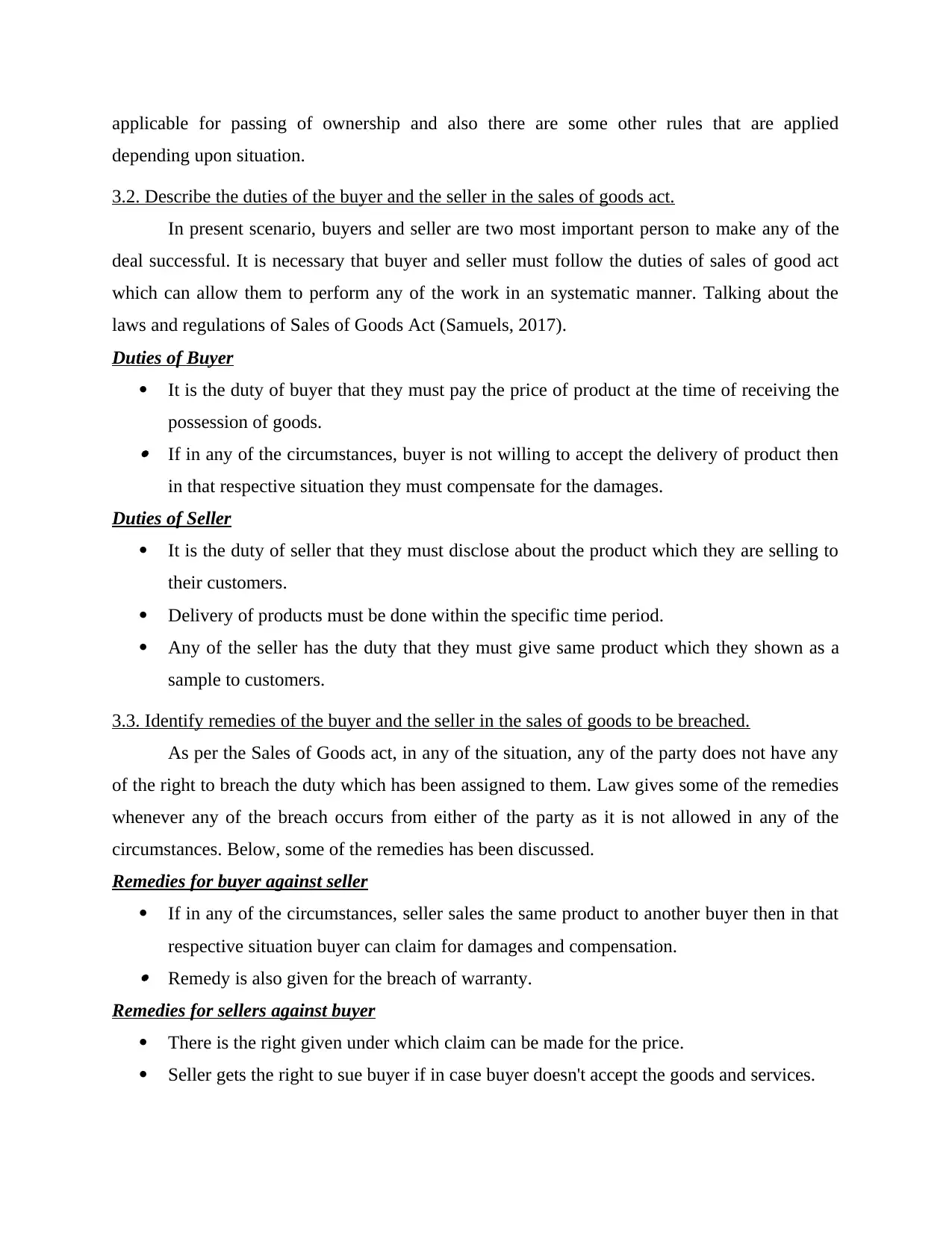
applicable for passing of ownership and also there are some other rules that are applied
depending upon situation.
3.2. Describe the duties of the buyer and the seller in the sales of goods act.
In present scenario, buyers and seller are two most important person to make any of the
deal successful. It is necessary that buyer and seller must follow the duties of sales of good act
which can allow them to perform any of the work in an systematic manner. Talking about the
laws and regulations of Sales of Goods Act (Samuels, 2017).
Duties of Buyer
It is the duty of buyer that they must pay the price of product at the time of receiving the
possession of goods. If in any of the circumstances, buyer is not willing to accept the delivery of product then
in that respective situation they must compensate for the damages.
Duties of Seller
It is the duty of seller that they must disclose about the product which they are selling to
their customers.
Delivery of products must be done within the specific time period.
Any of the seller has the duty that they must give same product which they shown as a
sample to customers.
3.3. Identify remedies of the buyer and the seller in the sales of goods to be breached.
As per the Sales of Goods act, in any of the situation, any of the party does not have any
of the right to breach the duty which has been assigned to them. Law gives some of the remedies
whenever any of the breach occurs from either of the party as it is not allowed in any of the
circumstances. Below, some of the remedies has been discussed.
Remedies for buyer against seller
If in any of the circumstances, seller sales the same product to another buyer then in that
respective situation buyer can claim for damages and compensation. Remedy is also given for the breach of warranty.
Remedies for sellers against buyer
There is the right given under which claim can be made for the price.
Seller gets the right to sue buyer if in case buyer doesn't accept the goods and services.
depending upon situation.
3.2. Describe the duties of the buyer and the seller in the sales of goods act.
In present scenario, buyers and seller are two most important person to make any of the
deal successful. It is necessary that buyer and seller must follow the duties of sales of good act
which can allow them to perform any of the work in an systematic manner. Talking about the
laws and regulations of Sales of Goods Act (Samuels, 2017).
Duties of Buyer
It is the duty of buyer that they must pay the price of product at the time of receiving the
possession of goods. If in any of the circumstances, buyer is not willing to accept the delivery of product then
in that respective situation they must compensate for the damages.
Duties of Seller
It is the duty of seller that they must disclose about the product which they are selling to
their customers.
Delivery of products must be done within the specific time period.
Any of the seller has the duty that they must give same product which they shown as a
sample to customers.
3.3. Identify remedies of the buyer and the seller in the sales of goods to be breached.
As per the Sales of Goods act, in any of the situation, any of the party does not have any
of the right to breach the duty which has been assigned to them. Law gives some of the remedies
whenever any of the breach occurs from either of the party as it is not allowed in any of the
circumstances. Below, some of the remedies has been discussed.
Remedies for buyer against seller
If in any of the circumstances, seller sales the same product to another buyer then in that
respective situation buyer can claim for damages and compensation. Remedy is also given for the breach of warranty.
Remedies for sellers against buyer
There is the right given under which claim can be made for the price.
Seller gets the right to sue buyer if in case buyer doesn't accept the goods and services.
Paraphrase This Document
Need a fresh take? Get an instant paraphrase of this document with our AI Paraphraser
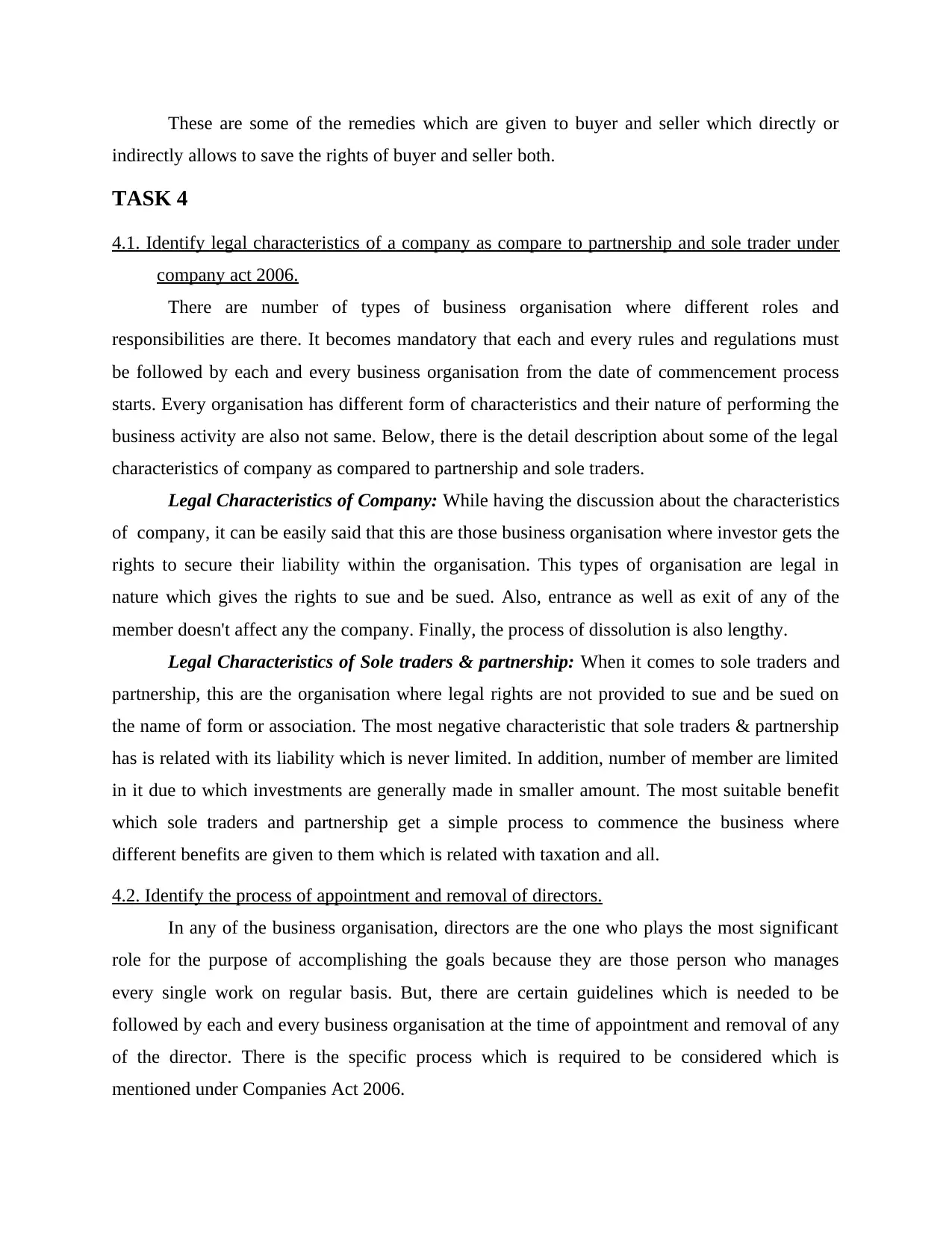
These are some of the remedies which are given to buyer and seller which directly or
indirectly allows to save the rights of buyer and seller both.
TASK 4
4.1. Identify legal characteristics of a company as compare to partnership and sole trader under
company act 2006.
There are number of types of business organisation where different roles and
responsibilities are there. It becomes mandatory that each and every rules and regulations must
be followed by each and every business organisation from the date of commencement process
starts. Every organisation has different form of characteristics and their nature of performing the
business activity are also not same. Below, there is the detail description about some of the legal
characteristics of company as compared to partnership and sole traders.
Legal Characteristics of Company: While having the discussion about the characteristics
of company, it can be easily said that this are those business organisation where investor gets the
rights to secure their liability within the organisation. This types of organisation are legal in
nature which gives the rights to sue and be sued. Also, entrance as well as exit of any of the
member doesn't affect any the company. Finally, the process of dissolution is also lengthy.
Legal Characteristics of Sole traders & partnership: When it comes to sole traders and
partnership, this are the organisation where legal rights are not provided to sue and be sued on
the name of form or association. The most negative characteristic that sole traders & partnership
has is related with its liability which is never limited. In addition, number of member are limited
in it due to which investments are generally made in smaller amount. The most suitable benefit
which sole traders and partnership get a simple process to commence the business where
different benefits are given to them which is related with taxation and all.
4.2. Identify the process of appointment and removal of directors.
In any of the business organisation, directors are the one who plays the most significant
role for the purpose of accomplishing the goals because they are those person who manages
every single work on regular basis. But, there are certain guidelines which is needed to be
followed by each and every business organisation at the time of appointment and removal of any
of the director. There is the specific process which is required to be considered which is
mentioned under Companies Act 2006.
indirectly allows to save the rights of buyer and seller both.
TASK 4
4.1. Identify legal characteristics of a company as compare to partnership and sole trader under
company act 2006.
There are number of types of business organisation where different roles and
responsibilities are there. It becomes mandatory that each and every rules and regulations must
be followed by each and every business organisation from the date of commencement process
starts. Every organisation has different form of characteristics and their nature of performing the
business activity are also not same. Below, there is the detail description about some of the legal
characteristics of company as compared to partnership and sole traders.
Legal Characteristics of Company: While having the discussion about the characteristics
of company, it can be easily said that this are those business organisation where investor gets the
rights to secure their liability within the organisation. This types of organisation are legal in
nature which gives the rights to sue and be sued. Also, entrance as well as exit of any of the
member doesn't affect any the company. Finally, the process of dissolution is also lengthy.
Legal Characteristics of Sole traders & partnership: When it comes to sole traders and
partnership, this are the organisation where legal rights are not provided to sue and be sued on
the name of form or association. The most negative characteristic that sole traders & partnership
has is related with its liability which is never limited. In addition, number of member are limited
in it due to which investments are generally made in smaller amount. The most suitable benefit
which sole traders and partnership get a simple process to commence the business where
different benefits are given to them which is related with taxation and all.
4.2. Identify the process of appointment and removal of directors.
In any of the business organisation, directors are the one who plays the most significant
role for the purpose of accomplishing the goals because they are those person who manages
every single work on regular basis. But, there are certain guidelines which is needed to be
followed by each and every business organisation at the time of appointment and removal of any
of the director. There is the specific process which is required to be considered which is
mentioned under Companies Act 2006.
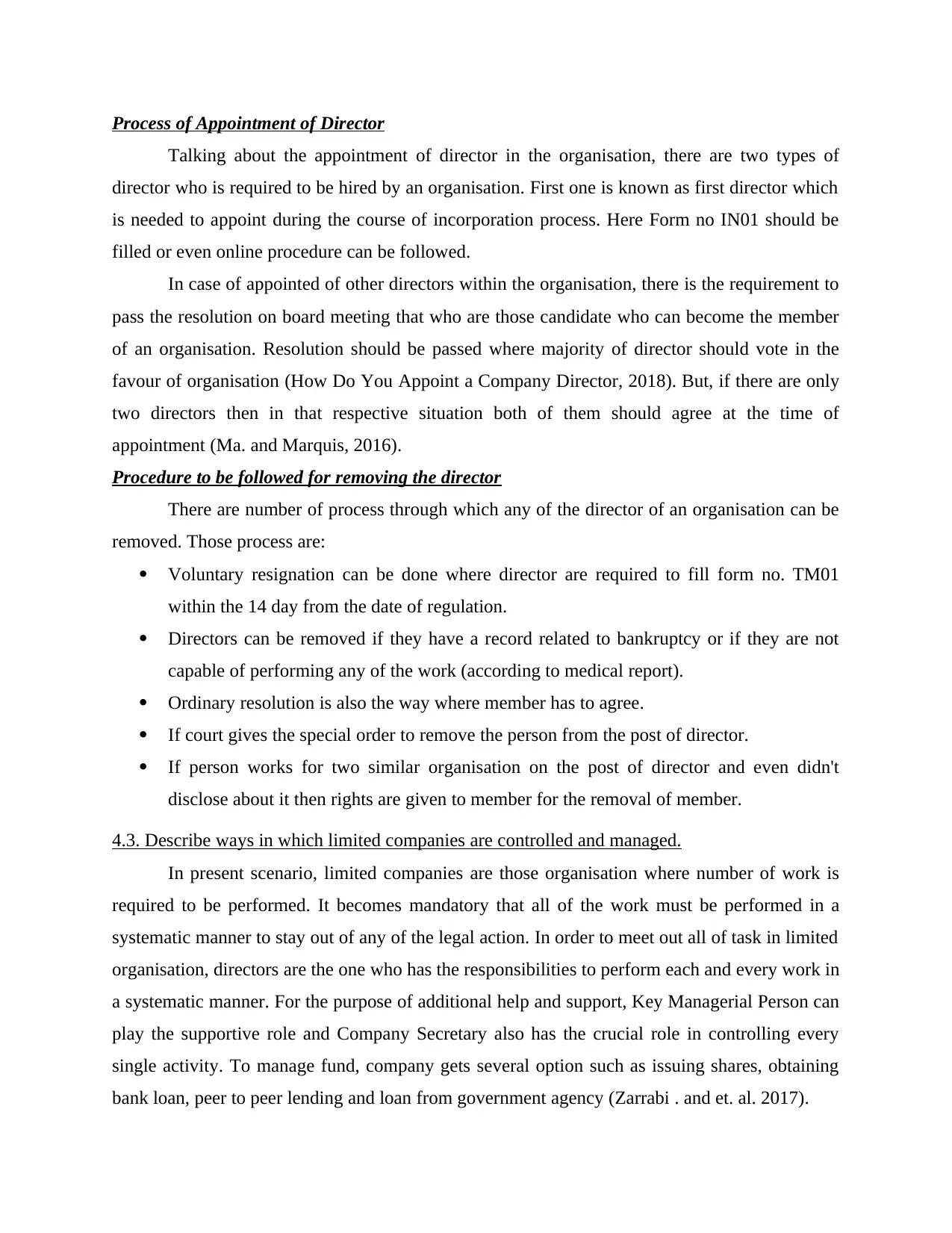
Process of Appointment of Director
Talking about the appointment of director in the organisation, there are two types of
director who is required to be hired by an organisation. First one is known as first director which
is needed to appoint during the course of incorporation process. Here Form no IN01 should be
filled or even online procedure can be followed.
In case of appointed of other directors within the organisation, there is the requirement to
pass the resolution on board meeting that who are those candidate who can become the member
of an organisation. Resolution should be passed where majority of director should vote in the
favour of organisation (How Do You Appoint a Company Director, 2018). But, if there are only
two directors then in that respective situation both of them should agree at the time of
appointment (Ma. and Marquis, 2016).
Procedure to be followed for removing the director
There are number of process through which any of the director of an organisation can be
removed. Those process are:
Voluntary resignation can be done where director are required to fill form no. TM01
within the 14 day from the date of regulation.
Directors can be removed if they have a record related to bankruptcy or if they are not
capable of performing any of the work (according to medical report).
Ordinary resolution is also the way where member has to agree.
If court gives the special order to remove the person from the post of director.
If person works for two similar organisation on the post of director and even didn't
disclose about it then rights are given to member for the removal of member.
4.3. Describe ways in which limited companies are controlled and managed.
In present scenario, limited companies are those organisation where number of work is
required to be performed. It becomes mandatory that all of the work must be performed in a
systematic manner to stay out of any of the legal action. In order to meet out all of task in limited
organisation, directors are the one who has the responsibilities to perform each and every work in
a systematic manner. For the purpose of additional help and support, Key Managerial Person can
play the supportive role and Company Secretary also has the crucial role in controlling every
single activity. To manage fund, company gets several option such as issuing shares, obtaining
bank loan, peer to peer lending and loan from government agency (Zarrabi . and et. al. 2017).
Talking about the appointment of director in the organisation, there are two types of
director who is required to be hired by an organisation. First one is known as first director which
is needed to appoint during the course of incorporation process. Here Form no IN01 should be
filled or even online procedure can be followed.
In case of appointed of other directors within the organisation, there is the requirement to
pass the resolution on board meeting that who are those candidate who can become the member
of an organisation. Resolution should be passed where majority of director should vote in the
favour of organisation (How Do You Appoint a Company Director, 2018). But, if there are only
two directors then in that respective situation both of them should agree at the time of
appointment (Ma. and Marquis, 2016).
Procedure to be followed for removing the director
There are number of process through which any of the director of an organisation can be
removed. Those process are:
Voluntary resignation can be done where director are required to fill form no. TM01
within the 14 day from the date of regulation.
Directors can be removed if they have a record related to bankruptcy or if they are not
capable of performing any of the work (according to medical report).
Ordinary resolution is also the way where member has to agree.
If court gives the special order to remove the person from the post of director.
If person works for two similar organisation on the post of director and even didn't
disclose about it then rights are given to member for the removal of member.
4.3. Describe ways in which limited companies are controlled and managed.
In present scenario, limited companies are those organisation where number of work is
required to be performed. It becomes mandatory that all of the work must be performed in a
systematic manner to stay out of any of the legal action. In order to meet out all of task in limited
organisation, directors are the one who has the responsibilities to perform each and every work in
a systematic manner. For the purpose of additional help and support, Key Managerial Person can
play the supportive role and Company Secretary also has the crucial role in controlling every
single activity. To manage fund, company gets several option such as issuing shares, obtaining
bank loan, peer to peer lending and loan from government agency (Zarrabi . and et. al. 2017).
⊘ This is a preview!⊘
Do you want full access?
Subscribe today to unlock all pages.

Trusted by 1+ million students worldwide
1 out of 16
Related Documents
Your All-in-One AI-Powered Toolkit for Academic Success.
+13062052269
info@desklib.com
Available 24*7 on WhatsApp / Email
![[object Object]](/_next/static/media/star-bottom.7253800d.svg)
Unlock your academic potential
Copyright © 2020–2025 A2Z Services. All Rights Reserved. Developed and managed by ZUCOL.





